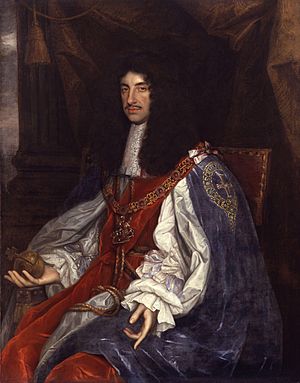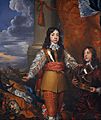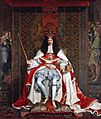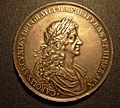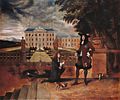Charles II of England facts for kids
Charles II (born May 29, 1630 – died February 6, 1685) was a King of Scotland from 1649 to 1651. He later became King of England, Scotland, and Ireland from 1660 until his death in 1685. This period is known as the Restoration.
Charles II was the oldest surviving child of Charles I of England and Henrietta Maria of France. His father, King Charles I, was executed in 1649 during the English Civil War. After this, the Parliament of Scotland declared Charles II their king. However, England became a republic, led by Oliver Cromwell. Cromwell defeated Charles II in battle, forcing Charles to flee to Europe.
Charles spent nine years living in other countries like France and the Netherlands. After Cromwell died in 1658, the monarchy was brought back. Charles was invited to return to Britain. On May 29, 1660, his 30th birthday, he was welcomed back to London with great celebration.
During his reign, Charles II worked with the English Parliament. He tried to allow more religious freedom for Catholics and Protestants who were not part of the official Church of England. He also faced wars with the Dutch. Charles II was known as the Merry Monarch because his court was lively and fun. He had many children, but none who could legally inherit the throne. His brother, James, became king after him.
Contents
The Life of Charles II
Early Years and Family
Prince Charles was the oldest son of King Charles I. From a young age, he was named Prince of Wales. This title showed that he was expected to become king one day.
When Charles was a young man, his father was fighting a war against Parliament. This was called the English Civil War. To keep them safe, Charles's mother, Henrietta Maria, took him and his siblings to France.
Becoming King in Exile
Charles was only 18 years old when he learned that his father had been executed. This meant he was now King Charles II. However, Parliament was in charge of Britain and would not let him rule.
In 1651, Charles II returned to Britain to fight for his throne. He fought Parliament at the Battle of Worcester. He lost the battle but managed to escape capture. He famously hid in an oak tree to avoid his enemies.
After his escape, Charles had to disguise himself as a servant. A brave young woman named Jane Lane helped him get away. He then sailed to Holland, where his supporters were. He lived there and had his own royal court until 1660.
The Return of the King
While Charles was in Holland, Britain was ruled by Oliver Cromwell. Cromwell was a strict leader chosen by Parliament. Many people grew tired of his rules. When Cromwell died in 1658, his son Richard took over.
Richard Cromwell was not a strong leader. Because of this, people asked King Charles II to come back and rule Britain again.
The Restoration of the Monarchy
In 1660, Charles II returned to Britain and took his place as king. This event is called the English Restoration. Many people who had fought against his father were punished. However, Richard Cromwell was allowed to live peacefully away from London.
Charles II was very popular. People called him "The Merry Monarch" because he changed many strict laws made by Cromwell. He allowed people more freedom to enjoy themselves. He loved going to the theatre, playing cards, and watching sports like horse racing. Some people thought a king should be more serious.
Religious Challenges
Some people did not like King Charles II because of his religious beliefs. His mother had raised him as a Roman Catholic. However, most people in England were Protestant.
Charles married Catherine of Braganza, a princess from Portugal. He tried to make laws that would allow more religious freedom for Catholics and other Protestants. But the English Parliament made him stop these efforts.
In 1679, a man named Titus Oates claimed there was a "Popish Plot" to kill the King. This caused a big crisis. It was also revealed that Charles's brother, James, who was next in line for the throne, had become a Roman Catholic. This led to a debate about whether James should be allowed to be king.
Ruling Alone
Charles sided with those who supported his brother. In 1683, a plot to murder Charles and James was discovered. Some of the plotters were punished or had to leave the country.
In 1681, Charles dissolved the English Parliament. He then ruled alone until he died in 1685. It is believed that he became a Catholic just before his death.
The King's Children
Charles II had many children, but none were born to his wife, Queen Catherine. This meant that none of his children could legally inherit the throne. His most well-known child was James Scott, who was given the title Duke of Monmouth.
When Charles II died suddenly, his brother James became King James II. James Scott, the Duke of Monmouth, tried to start a rebellion to become king himself. But he was defeated by the royal army and executed.
Images for kids
-
Portrait by William Dobson, c. 1642 or 1643
-
Charles in exile, painted by Philippe de Champaigne, c. 1653
-
Coronation portrait: Charles was crowned at Westminster Abbey on 23 April 1661.
-
Charles II in profile on a medal struck in 1667 by John Roettier to commemorate the Second Dutch War
-
Charles was presented with the first pineapple grown in England in 1675. Painting by Hendrick Danckerts.
-
Statue of Charles II as a Roman Caesar, erected 1685, Parliament Square, Edinburgh
-
Statue of Charles II (c. 1682) in ancient Roman dress by Grinling Gibbons at the Royal Hospital Chelsea
See also
 In Spanish: Carlos II de Inglaterra para niños
In Spanish: Carlos II de Inglaterra para niños


